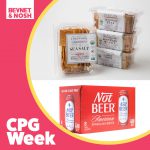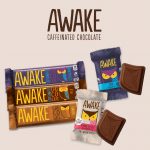Fast Companies: Brands Fuel Instant Innovations in Coffee & Tea
They say good things come to those who wait. But for coffee and tea drinkers, that sentiment may be changing.
As anyone who’s waited for their barista to prepare their pour over is well aware, there’s often a clear correlation between time and quality in coffee and tea preparation: in theory, the longer it takes to prepare, the more rewarding the drinking experience should be. But if that same artisan beverage craftsmanship can be replicated in a fast and convenient format, would that idea still hold true? In the shadow of the third-wave coffee movement, a group of young startup brands are exploring ways to disrupt the coffee and tea industries with a new generation of versatile, high-end instant products.
FROM CAMP TO CUP
In 2017, instant coffee is something of an anachronism to many mainstream consumers. Who needs freeze dried coffee crystals when there’s a Starbucks on every corner and highway rest stop, or when the interest in hand-crafted specialty coffee is at an all time high? The answer is many; according to a report from market research firm IMARC Group, the global instant coffee market grew at a CAGR of 3.6 percent from 2009 to 2016, reaching a total value of $9.9 billion last year.

Popularized as a mainstream consumer product post-World War II, instant coffee has been largely dominated by a few core legacy brands backed by CPG giants, such as Taster’s Choice (produced by Nestle), Maxwell House (The Kraft-Heinz Company) and Folgers (The J.M. Smucker Company). Within the category, outdoor enthusiasts and campers represent a key consumer group, and several of the entrepreneurs seeking to bring the category forward found inspiration to start their businesses while on camping expeditions themselves.
Matt Segal, co-founder of Alpine Start, came to partner Alex Hanifin with his idea for a new instant coffee company after a climbing trip in Canada. “We realized there was a gap in the category, with older brands such as Starbucks and Nescafe but no new innovation and nothing that tasted good to our palates,” said Hanifin in an email. “We wanted to create something different, something young and fresh that our friends (adventurous millennial consumers) would be attracted to.”
For tea aficionados, the need for a higher quality instant product was particularly felt.
“When you are outdoors, there’s a significant inconvenience for having a tea bag because you can’t just throw it out in the woods– you have to pack it out, and it’s one of the rare things that heavier coming back than going out into the mountains,” said Jim Lamancusa, founder of instant tea brand Cusa Tea. A former VP of sales at GoodBelly, Lamancusa was enjoying a hike with friends and trying to figure out his next career move when he noticed everyone else in his group was drinking Starbucks VIA instant coffee. “Why don’t I have Starbucks Via but for tea?,” he remembered asking himself.
San Francisco-based Sudden Coffee, meanwhile, found its inspiration for instant in the Bay Area’s thriving specialty coffee scene, as co-founder Kalle Freese, an experienced barista, sought a way to bring the third-wave coffee experience to a wider range of consumers. After an encouraging discussion with a former Nespresso coffee scientist at a conference, he and co-founder Joshua Zloof committed themselves to developing an instant coffee product with a distinct premium positioning.
“I think the timing in the market has been ready for it, where you seen this really big rise in specialty coffee,” Aloof told BevNET. “It had hit this point where people were used to paying $3 for a cup of coffee, or even up to $6. There was an understanding of that, and yet there are a lot of people outside of big cities that just don’t have access to it. They go to San Francisco, they’ll try Blue Bottle Coffee, and then they’ll go back home and have to order beans and grind it and learn all this other stuff.”
BUILDING THE CUP
Translating the specialty coffee or tea experience into an instant drink begins with high quality sourcing. Sudden works with Vancouver-based roaster 49th Parallel to develop the flavor profile for its beans, and then brews them using a proprietary method which aims to replicate the way in which it would be prepared in a specialty cafe.
“It ends up being more costly because we are using the best quality beans and not focusing on yield,” said Zloof. “We are also using a brewing process that is a lot more technical and complicated than regular instant. There’s a direct correlation between cost and taste, so all of those factors make it a higher cost process.”
For longtime instant coffee brands, such as Taster’s Choice, the production process is tailored to keep those costs low. Commodity level beans are roasted and brewed hot in large quantities, turned into a liquid extract, and then either spray dried or freeze dried into crystals, which can result in the gritty, bitter taste often associated with instant coffee. In 2009, Starbucks introduced Via, which uses a process called micronization to grind coffee into particles small enough that they stay suspended in water and better retain the beans true flavors.

In creating Cusa, Jim Lamancusa initially opted to follow Starbucks’ lead, even hiring a food scientist who helped the coffee giant develop Via. “I thought it was going to be a slam dunk,” he said. “We’ll apply the same technology Starbucks uses but do it for tea and get to the market fast.” But it wasn’t quite that simple: after five months and significant investment in R&D, the microground organic tea leaves were still sinking to the bottom of the cup and creating a sludgy mouthfeel. Further on, when experimenting with spray drying versus freeze drying, he found that both turned the flavorful teas bland and tasteless.
As Lamancusa found, whether making instant coffee or tea, the key to achieving rich flavor is controlling heat. His breakthrough came when he began cold brewing tea, allowing it to steep at room temperature and then straining out the leaves before steeping the liquid a second time with fresh fruits. Rather than freeze or spray drying, the liquid is put into a gentler, slower drying process called vacuum dehydration, resulting in instant crystals that can mirror the taste of fresh brewed tea.
“All these technologies exist,” said Lamancusa, who spent seven months working out processing issues. “I didn’t create anything, but I’m the first to do it with tea leaves in this way.”
In developing Pique, which founder and CEO Simon Cheng defines as a “cold brewed tea crystal,” the brand updated a traditional Tibetan preparation method in which teas are boiled and the plant matter extracted until just a paste remains. Cheng said that by using a cold extraction Pique is able to preserve both the tea’s active ingredients and its flavor.
Scaling this type of production, however, is not an inexpensive proposition. But investors have been eager to step in with financial support thus far. Last November, Sudden Coffee completed a $2.8 million seed round of fundraising led by Charles River Ventures, and the company was recently accepted into the influential startup incubator Y Combinator for its winter 2017 accelerator program. Meanwhile, Pique counts private equity firms such as Coastal Ventures, Blueberry Ventures and First Round Capital as investors in the company, and will be participating in the Chobani Food Incubator this fall.
“Out mission is to make what is widely recognized as the world’s healthiest beverage as easy to consume as water,” said Cheng. “[Chobani founder] Hamdi Ulukaya did something similar: he basically made a healthier, much better kind of yogurt accessible to anyone, and actually helped a lot of people become healthier. That’s basically what we’re doing in the world of hydration.”
BUILDING THE BRAND
For Sudden, building off the momentum surrounding the specialty coffee market has its share of challenges. By inviting comparison to the coffee served at high-end cafes, the young brand is forced to make a compelling case for why its instant product should be considered as more than just a convenience play but rather as a direct replacement for a fresh brewed cup. According to Zloof, that means using a subscription-based e-commerce model to serve consumers outside of major urban areas.
“The phase of the business we are in right now is how do we tell our story well,” said Zloof, noting how Sudden includes personalized notes and coffee education materials in its packages to help build a deeper connection with consumers. “There are a whole bunch of people outside of big cities that don’t have access to a great cafe. It’s not like we have to say ‘hey, don’t go to your favorite cafe.’ The only thing they have nearby is Starbucks or Dunkin. For those people, this is a great way for them to experience specialty coffee, especially for the first time.”
Leaving outdoor retailers out of that strategy, Zloof said, was a specific choice. “We have been frequently asked about getting into camping stores, but we really want to be an important part of someone’s coffee routine or experience for an individual, and so that filler model of consumers buying [instant coffee] once or twice a year, it didn’t really match up with our values and our goals.”

Taking a less targeted approach, Hanifin suggested that consumers themselves would ultimately define how they interpret Alpine Start’s convenience-based premium offering. “I don’t believe in telling you how or when to enjoy your coffee,” she wrote of Alpine Start, which is sold in conventional and national retailers, as well as REI stores nationwide. “We began thinking this would be used specifically while camping but we soon realized that a lot of our consumers use our product at home, while traveling or in the office. Our stance has now evolved to wanting to be the ‘second cup’ of coffee.”
Both Cusa Tea and Pique also offer subscription-based models, but otherwise the two brands have thus far pursued divergent routes to market. With subscriptions representing only about 10 percent of its business, Cusa is committed to building in the natural channel and at outdoor retailers; its products are currently available in 65 natural grocery stores and 40 outdoor shops, and is due to launch at REI in spring 2018. Lamancusa recognized the unique demands of consumers in each category.
“To be blunt, the outdoor industry is a little bit lower hanging fruit so far,” he said. “We don’t really need to demo in the outdoor shops, because, like it or not, the outdoor consumer is used to sacrificing taste for convenience. But even if the consumer buys it for the first time at an outdoor shop and they are expecting it to not taste as good, but then they taste it and it does, now I have a consumer that I brought in from the outdoors, but it can follow them when they are traveling or other use occasions.”
Lamancusa emphasized that, in his view, Cusa Tea, though merchandised in the tea aisle, should not be considered as competition for loose leaf teas and tea bags at retail, and he tells buyers so.
“We’re providing a different consumption option, so the ideal would be for us to help raise the store sales, because now consumers can drink tea at a different time,” he said. “I never want to get rid of tea bags or loose leaf tea; there’s a ritual of making tea that is important. It’s more that retailers don’t need a fifth Earl Grey brand.”
Cheng, meanwhile, sees Pique as a disruptive product that can deliver a superior experience to both loose leaf teas and bags, and also to ready-to-drink beverages. Along with citing tests that he claimed showed Pique had a significantly higher antioxidant and polyphenol content than both loose leaf and bottled teas, he also noted the product’s appeal as a way to reduce plastic bottle waste. Rather than position it as a niche product, Cheng said Pique is not focused on building in the outdoor retail channel as much as in natural and conventional groceries.
Finding a price point that communicates both convenience and craft will be a key factor in achieving the mainstream acceptance that Cheng is seeking for Pique. “One of the reasons we were accepted into Chobani’s incubator is because Hamdi [Ulukaya] believes in accessibility,” he added. “You can have the best product in the world, but if people can’t afford it, what kind of impact are you making?
While building connections with individual consumers, the next wave of instant coffee and tea brands are also already looking beyond to further innovations in both production and merchandising. Lamancusa pointed towards opportunities in food service, in which Cusa will soon be launching a three gallon pouch format that would allow restaurants and cafes to prepare cold or hot tea in bulk and save on labor and ingredient costs. Both Lamancusa and Cheng also hinted at future non-tea instant products, suggesting that the technology could provide a platform for growth in herbal and other plant-based supplements in the future.
“The vision that I have, and it’s exciting to see it happening so quickly, is a world where extracts become the beverage default, as opposed to things that come in bottles,” said Cheng.













